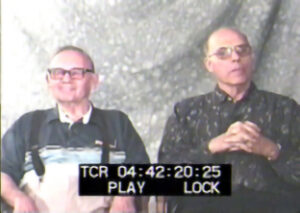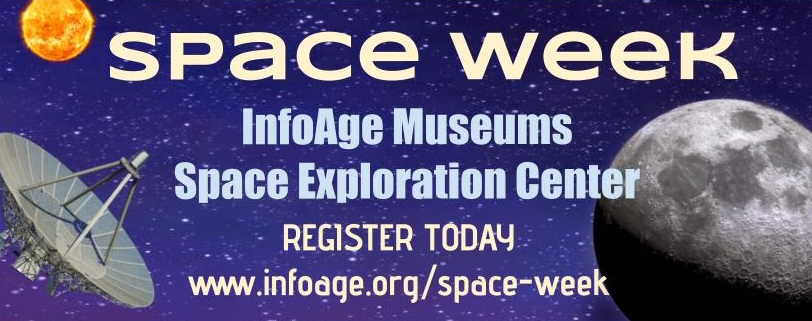The History of InfoAge Science & History Museums
Oral Histories - Oral History David L. Pfaff & John M. Woodworth Interviewer: Michael Ruane
Interviewer: Michael Ruane
Date: 1998?
Place: Camp Evans – 9039
Media: NTSC Video
Summary: Mr. Irv Bauman
TAPE 4B DAVID L. PFAFF; JOHN M. Woodworth, EW LABORATORY
David L. Pfaff, graduated from Michigan State U, in Electrical Engineering. He started in Evans in Fall 1955. He took an orientation course, then was assigned to the Direction Finding Branch under Harold M. Jaffe, an innovator. He continued working until 1972. John M. Reuter graduated from Northeastern University, Boston, with EE degree. He started working in 1942 at Ft. Monmouth, Eatontown for 2 yrs. He then joined U.S.Army and after discharge was hired at Evans to join the Antenna & Direction Finding Branch in Bldg. 21, Evans in 1946. He worked on AN/TRD-1, Portable Direction Finder. He worked at Evans to 1952, then Coles for 2 yrs, then back to Evans to 1970. He worked on PID-1 in 1946 &.RDF location of arrival of enemy signals, by triangulating those with 3 ea. sensors to get enemy locations. He worked on SCR 201, 206 in development. He stayed on after WWII and during the Korean War got involved with antenna installation on the wings of aircraft. Three pilots would manoeuver their a/c, receiving their enemy signals, which in turn would be triangulated to reveal enemy positions. Later this function was achieved with the use of a single a/c and pilot with advanced equipment installed, and a data link to the ground that had a remote control. He left labs in 1977 and his work is being continued by others.
During the McCarthy Hearings, his boss, Jack Kaplan was targeted and had to leave Evans. He then made his living selling cars. John would drive to work with Jack, who was found guilty by association. This was later rescinded when he was found to be the wrong “Jack Kaplan”. RDF items, homing devices, were given code names, which had, in common the letters CEF / LEF, like Left Job, Left Bank, Cafe Blew, Laughing Eagle; others with whiskey designations like Seven Roses. The shops would build these items and ship them overseas. These were developed for Army Security Agency.
Since 1942, John’s experience was only with vacuum tubes, using commercially available tubes as well as available batteries. The latter was large and so he recommended battery miniaturization. In military service, John was an S/Sgt assigned to a tank unit repairing army radios. John worked with Lakehurst & St. Louis to modify a/c installing antennas all over the plane skins. John recalls one incident where a Mike Kukakis was flying a plane about to land, but an antenna had dropped under the plane and had to raise for landing. Having no tools, he managed to use a coin to pull the antenna up, just in time to land the aircraft. John related another incident that occurred during a coffee break in Evan’s Cafeteria, where shop employees would gather during their break. A man known as Stoney erected an inflatable antenna 60 ft. high, known as (Trojan) just outside of the building for all to see.
David L. Pfaff first worked on low drain tubes in man-portable sets and on circuits using these tubes. Also, the reduction of PRD-1 size was worked on. A contractor built the first set to Evans specification, a VHF radio set with VHF antenna weighing 20 lbs in 2 packages. The radio was 14″x6″x6″. Low-Temperature batteries were developed. A series of HF & UHF sets were tested in Panama & Florida, then overseas to Vietnam. He gave technical assistance to Vietnam & Korea & his technicians were sent to different stations. VHFDF-25 miles, line of sight, HFDF – longer range. Dave worked on ground systems and contributed to the Cold War for ASA. The TRD-16 Direction Finder Set was used to monitor E. Germany from Russia. These systems were installed on hills overlooking the Berlin Wall to observe the German activity. They also looked at Russian HF locations observing radios that Russians used. ASA was interested in learning what radios were in use. ASA would interrupt messages. Dave also worked on solving ionosphere problems where HF & VHF signals were hard to pick up. He also tried to improve the signal to noise ratios.
ASA was omitted to fighting the Cold War. Three DF sets, hundreds of miles apart would be tuned to one location and by triangulation, pick up locations in Thailand, Vietnam, & Phu Bai. Dave traveled with Jim Cummings. Many lab people were in Vietnam supporting the troops. Manpack equipment was built in Evans and used to locate HF sets and mortar groups. DF is different than Radar. David wrote draft specifications for ASA who funded programs and contracts were awarded “Statements of Work” to promote quick reaction sole source procurements with letter awards. The price could be negotiated later. Collingswood Circle was a field site location where some testing was done. Companies cooperated with laboratories in any way they could for Uncle Sam. The EDTL Group used lots of commercial equipment but pushed contractors to come up with improved items. In 1971 a special project developed system on HF direction finding was demonstrated.
Photos of antenna installations were taken by Harold Jaffe and would be made available later.
48 minutes
Page created August 2, 2002
We Need Your Help! Volunteer with Us.
Join our mission to preserve historic Camp Evans and teach the public about science and history.
Sign up to join our team of volunteers and start on your own mission today.
InfoAge Science & History Museums
2201 Marconi Road
Wall, NJ 07719
Tel: 732-280-3000
info@infoage.org
webmaster@infoage.org

